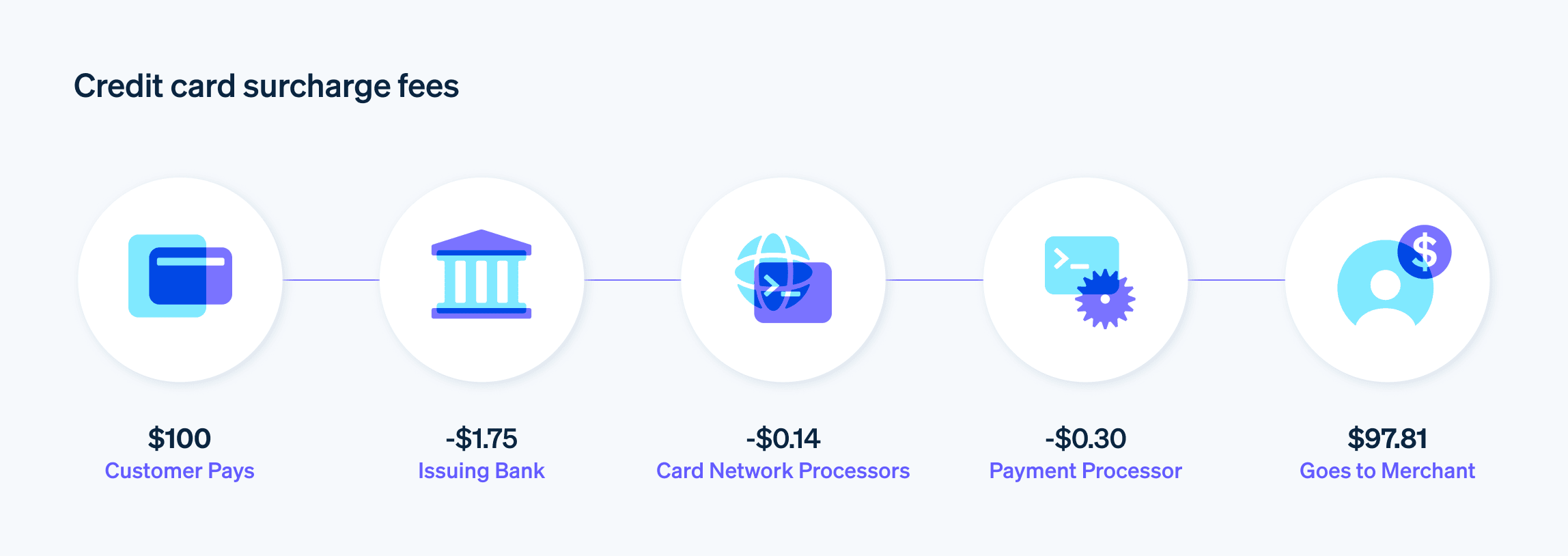信用卡附加费是指当客户使用信用卡进行支付时,企业可能会在交易中增加的额外费用。这项附加费的目的是支付企业处理信用卡支付所产生的费用。企业向信用卡公司和支付处理商支付的这些费用通常占交易额的一定比例,是一笔不小的开支。2022 年,为接受约 10 万亿美元的信用卡、借记卡和预付卡支付,美国企业支付了超过 1600 亿美元的手续费。
附加费可能会根据企业与其支付处理商之间的协议而有所不同。手续费通常只占交易总额的一小部分。收取附加费的目的是抵消企业接受信用卡的成本,其中包括交换费、评估费和支付处理商费用等费用。
下面深入探讨企业信用卡附加费:它们是如何运作的,能带来哪些好处,以及以不损害客户满意度的战略方式实施信用卡附加费的最佳实践。以下是企业须知。
目录
- 企业为什么要收取信用卡附加费?
- 信用卡附加费规则
- 企业在收取附加费之前应考虑哪些因素?
- 附加费政策的最佳做法
- 信用卡附加费的利弊
- 信用卡附加费的替代方案
为什么企业要收取信用卡附加费?
企业收取信用卡附加费是为了抵消处理信用卡交易的相关成本。当客户使用信用卡支付时,企业会从银行或支付处理商那里产生费用。这些费用可能包括交易金额的某个百分比,以及每笔交易的固定费用。企业征收附加费的目的是收回这些成本,而不是接受这些成本,这对小企业或利润微薄的企业尤为重要。
除了直接的处理费用外,还有与接受信用卡相关的其他费用。其中包括维护必要硬件和软件的成本,以及遵守安全标准以保护持卡人数据的成本。信用卡欺诈是另一个令人担忧的问题,企业在发生欺诈交易的情况下往往要承担拒付的成本。
附加费也可以成为企业的一项战略决策。企业可以利用它们来鼓励客户使用现金或借记卡等手续费较低或无手续费的替代支付方式。

信用卡附加费规则
在美国,每个州对信用卡附加费的规定不尽相同。以下是不同辖区监管环境的概述。
美国全国附加费规则
- 在美国通常允许收取信用卡附加费。
- 这些附加费加在信用卡交易中,用于支付处理费用。
- 附加费金额通常是交易额的一个百分比。
- 企业必须在交易前将附加费告知客户。
- 信用卡网络(如维萨和万事达卡)都有关于附加费的指南。其中包括附加费限额以及对网络和客户的通知要求。
州的具体规则
- 加利福尼亚州:以前禁止收取附加费,但最近的法律修改允许在某些条件下收取附加费。
- 科罗拉多州:允许收取附加费,但有具体的披露要求。
- 康涅狄格州:禁止收取信用卡附加费。
- 佛罗里达州:曾禁止收取附加费,但法律修订允许在某些情况下收取附加费。
- 堪萨斯州:允许收取附加费,但企业必须遵守披露和透明度要求。
- 缅因州:允许收取附加费,但须符合某些条件并进行披露。
- 马萨诸塞州:禁止收取信用卡附加费。
- 纽约州:以前曾有禁令,但法律裁决允许收取附加费,并有严格的披露要求。
- 俄克拉荷马州:允许收取附加费,但企业必须遵守披露规则。
- 得克萨斯州:允许收取附加费,并规定了通知客户的具体要求。
每个州都有自己的信用卡附加费监管方式,反映了不同的消费者保护和企业运营政策。有些州允许在某些条件下收取附加费,有些州则有更严格的规定或直接禁止。在国际上或在多个州开展业务的企业有义务了解并遵守这些法规;否则,他们将面临法律问题和其他复杂情况的风险。
全球考虑因素
- 在美国以外的一些国家/地区,对附加费有不同的规定或禁止收取附加费。
- 对于跨国企业来说,遵守当地法律和信用卡网络规则尤为重要。
企业在收取附加费之前应考虑哪些因素?
在征收附加费之前,企业应考虑以下因素:
遵守法律
首先,企业必须确保收取附加费在本州或本地区是合法的。这意味着要了解当地有关附加费的具体法律法规。信用卡网络规则
企业必须了解并遵守维萨卡、万事达卡和美国运通卡等信用卡网络制定的规则。这些规则包括附加费金额限制和客户通知要求。客户透明度
就任何额外费用与客户进行明确沟通是关键。企业可以通过醒目的标识、网站声明或交易过程中的口头通知来实现这一目标。对客户行为的影响
请考虑附加费如何影响客户的选择。一些客户可能会选择其他支付方式,如果他们觉得附加费不公平,甚至会选择不同的企业。成本效益分析
企业应评估附加费带来的额外收入是否超过来下客户由于额外的费用而寻求替代方案的潜在业务损失。行政管理费用
实施和管理附加费可能需要更改计费系统和增加行政工作。市场地位和竞争
了解竞争对手如何处理信用卡费用非常重要。如果竞争对手正在接受这些成本,那么增加附加费可能会使企业处于不利地位。客户关系和满意度
有些客户可能会认为附加费是一个很大的缺点,因此必须在经济收益和客户满意度之间取得平衡。信用卡交易频率
信用卡交易量大的企业可能会发现,附加费有助于抵消手续费,但信用卡消费较少的企业可能受到的影响有限。替代支付激励措施
与其依赖附加费,不如提供激励措施,鼓励客户使用现金或借记卡等费用更低的支付方式。
仔细考虑这些因素可以帮助企业做出明智的决定,决定是否实施附加费,以及如何在财务需求与客户期望和法律要求之间取得平衡。
附加费政策的最佳做法
企业必须在附加费问题上取得微妙的平衡:既要收回成本,又要让客户满意。对信用卡支付收取过高的附加费可能会节省交易费,但却会危及客户的满意度和忠诚度。
实施附加费政策的最佳做法需要仔细考虑几个方面:
确保遵守法律法规
确保您的附加费政策符合当地法律和信用卡网络规定。这包括遵守对最高允许附加费的任何限制,并确保您的附加费足以支付交易处理的成本,但不会产生利润。与客户保持透明沟通
以直接、明确的方式向客户公布附加费政策。您可以通过实体店的明显标识、交易过程中的明确提及以及网站和收据上的声明来做到这一点。重要的是,客户要在完成交易前了解附加费。确定合理的附加费水平
将附加费设定在既能收回成本又对客户公平的水平上。过高的附加费会把顾客赶走。常见的做法是将附加费设定在与信用卡公司收取的交易费相当的水平。进行定期审查和调整
定期审查并在必要时调整附加费率,尤其是在处理成本发生变化时。这可确保您的附加费与实际成本和法律要求保持一致。培训工作人员
对员工进行培训,使他们能够有效地向客户解释附加费政策。工作人员应能回答问题并解释为什么要收取附加费以及如何计算。提供多种支付方式
为客户提供多种支付方式,包括现金和借记卡等不产生附加费用的支付方式。有些企业还为非信用卡支付提供折扣。分析客户反馈
关注客户对附加费的反馈。为了维持积极的客户关系,如果发现客户有明显的不满或困惑,就应调整策略。记录政策
确保附加费政策有据可查。其中应包括如何计算附加费、如何使用附加费以及任何相关法律合规信息的详细信息。这些文件有助于员工培训和解决客户的任何询问。避免卡类型之间的歧视
如果当地法律以及与信用卡网络签订的协议允许,应对所有类型的信用卡统一收取附加费。区分卡类型可能会导致问题复杂化和客户不满。定期监测法律变化
随时了解法律和信用卡网络规则的变化。收取附加费的做法可能会受到新法律、法院判决或信用卡网络政策变化的影响。定期更新会验证持续合规性和运行效率。
遵循这些做法的企业可以实施公平、合法、透明且对客户关系干扰最小的附加费政策。
信用卡附加费的利弊
企业的附加费政策应反映其希望提供的客户体验。虽然收回交易成本的财务优势显而易见,但重要的是要考虑附加费如何影响客户关系和客户消费方式的大局,以免因小失大。下面我们就来看看信用卡附加费的利弊。
实施附加费政策的优点
收回交易成本
对企业的主要好处之一是能够收回处理信用卡支付所产生的成本,其中可能包括基于百分比的费用、每笔交易的费用以及支付处理商的月费。减少开销
通过增加附加费,企业可以减少与信用卡交易相关的管理费用,从而避免全面提价,使产品或服务更实惠。鼓励替代支付
附加费可以鼓励客户使用现金或借记卡等费用较低的替代支付方式,从而降低企业的总体交易费用。
实施附加费政策的缺点
顾客的负面反应
客户可能会对附加费持负面看法,认为这是对使用首选支付方式的惩罚。这可能会导致不满,或将业务转给不加收此类费用的竞争对手。定价的复杂性
实施附加费会使定价结构变得复杂,可能导致销售点的混乱,因为客户可能直到最后一刻才意识到这笔额外的费用。抑制支出
一些客户可能会改变消费习惯,避免使用信用卡消费,这可能意味着企业有可能失去更大的销售额。保持合规性
遵守各种各样的法规和合规要求可能令人生畏。这些规则会因地点甚至信用卡网络的不同而有所差异,需要认真监督。
信用卡附加费的替代方案
如果企业想规避信用卡附加费,可以考虑一系列方案。其中包括:
使用具有成本效益的支付处理商
Stripe等支付处理商提供有竞争力的费率和定价结构,可以降低交易成本。通过分析不同的支付处理商并选择费用较低的处理商,企业可以减少或消除增加附加费的需要。选择最佳销售点系统
选择合适的销售点 (POS) 系统对交易来说很关键。有些系统提供更优惠的费率,或更适合企业特定的交易模式。一个易于与业务运营整合的 POS 系统可以减少处理时间和成本。就商家服务进行谈判
企业可以与商家服务提供商协商条款。有些提供商可能会根据交易量或长期客户忠诚度提供较低的费率。激励成本较低的支付方式
为使用现金、支票或 ACH 转账提供折扣,可以激励客户使用这些成本较低的方式。这可以间接减少信用卡交易量和相关费用。批量交易
通过分批而不是逐笔处理交易,企业可以减少信用卡处理商通常收取的每笔交易费用。收取服务费
有些企业对所有交易收取小额服务费,而不是收取特定的信用卡附加费。这种方式对客户来说更容易接受,而且可以避免与信用卡附加费相关的负面印象。提供会员制或忠诚度计划
引入将支付处理费包含在会员费中的计划,可以将处理费用分摊到更大的范围内,减少对单笔交易的影响。减少卡支付接受度
一些企业限制小额交易使用信用卡,因为手续费会占去收入的很大一部分。提高运营效率
简化业务运营以降低成本可以抵消支付处理费用。这可能涉及优化库存管理、减少浪费或改善客户服务以提高客户保留率。允许接受成本
一些企业可能会决定接受这些费用,通过微调所有产品和服务的价格来实现平衡。
选择正确的信用卡附加费替代方案应是企业对客户服务承诺的延伸,并与企业的运营相适应。我们的目标是保持盈利,同时为客户提供公平和便利的交易。
本文中的内容仅供一般信息和教育目的,不应被解释为法律或税务建议。Stripe 不保证或担保文章中信息的准确性、完整性、充分性或时效性。您应该寻求在您的司法管辖区获得执业许可的合格律师或会计师的建议,以就您的特定情况提供建议。